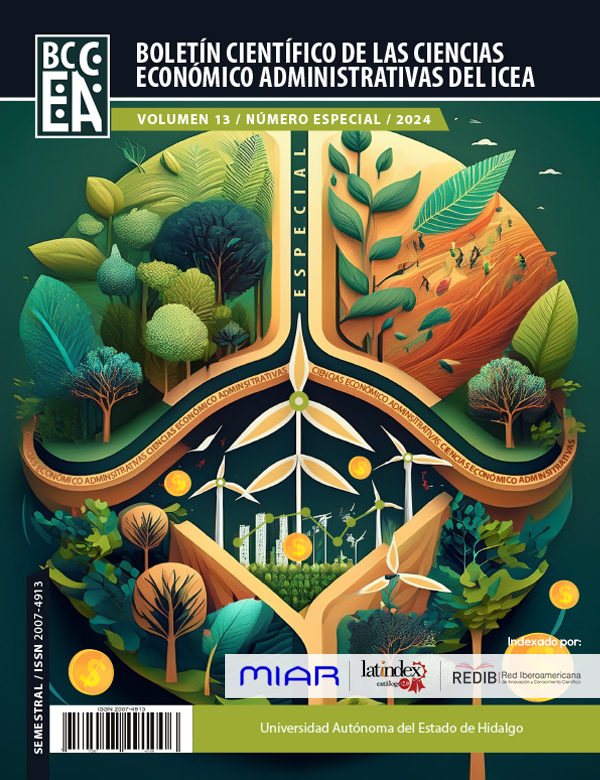Estimating the Environmental Kuznets Curve for Mexico 1974-2020
Abstract
The article seeks to validate the Environmental Kuznets Curve (EKC) in the Mexican economy. To achieve this, we utilize annual data aggregate between 1973 and 2020 to test the long-term quadratic relationship (inverted ‘U’ shape) between pollution levels (CO2 emissions) and income level (GDP per capita). We model empirically the EKC following a time series approach, Autoregressive Distributed Lags (ARDL), which captures both short and long-term relationships between the two variables. The estimation results indicate that the EKC holds for the analyzed period, suggesting that CO2 emissions are determined by the level of per capita income.
Downloads
References
OECD. The economic consequences of outdoor air pollution. Policy Highlights. 2016.
IQAir. Países y regiones con mayor contaminación del mundo. 2023.[En línea]. Disponible en: https://www.iqair.com/mx/world-most-polluted-countries.
Grossman G. y Krueger A. Enviromental Impacts of a North American Trade Agreement, s.l.: National Bureau for Economic Reasearch, 1991.
Selden, T. y Song, D., Environmental Quality and Development: is there a Kuznets Curve for Aire Pollution Emissions?. Journal of Environmental Economics and Management, 1994; 147-162.
Navarrete, M., Brull, A., Gómez, D. Verificación de la Curva Ambiental de Kuznets: El caso de México. Revista Estudiantil de Economía Tecnológico de Monterrey. 2008; 1(1): 37-54.
Ahmad, M., Muslija, A. y Satrovic, E. Does economic prosperity lead to environmental sustainability in developing economies? Environmental Kuznets curve theory. Environmental Science and Poullution Research. 2021; (28): 22588-22601.
Pesaran, H., Shin, Y., Smith, R. Bounds Testing Approaches to the Analysis of Level Relationships. Journal of Applied Econometrics. 2001; 16(3): 289-326.
Jalil, A. y Mahmud, S. Environment Kuznets curve for C02 emissions: A cointegration analysis for China. Energy Policy. 2009; (37): 5167-5172.
Bölük, G. y Mert, M. The renewable energy, growth and environmental Kuznets curve in Turkey: An ARDL approach. Renewable and Sustainable Energy Reviews. 2015; (52): 587-595.
Ang, J. CO2 emissions, energy consumption, and output in France. Energy Policy. 2007; 35(10): 4772-4778.
Wang, Y., Zhang, C., Lu, A., Tojo, J. A dissagregated analysis of the environmental Kuznets curve for industrial CO2 emissions in China. Applied Energy. 2017; (190): 172-180.
Stock, J. y Watson, M. Introduction to Econometrics. Fourth Edition, New York: Pearson, 2019.
Pesaran, H. Time Series and Panel Data Econometrics., Cambridge: Oxford University Press, 2015.
Kripfganz, S. y Schneider, D. Estimating autoregressive distributed lag and equilibrium correction models. London , 2018.
Kripfganz, D. Response Surface Regressions for Critical Value Bounds and Approximate p-values in Equilibrium Correction Models. OXFORD BULLETIN OF ECONOMICS AND STATISTICS. 2020; 82(6): 1456-1481.
Dickey, D. y Fuller, W. Distribution of the Estimators for Autoregressive Time Series With a Unit Root. Journal of the American Statistical Association. 1979; 74(366): 427-431.
Phillips, P. y Perron, P. Testing for a Unit Root in Time Series Regression. Biometrika. 1988. 75(2); 335-346.
Kwiatkowski, D., Phillips, P., Schmidt, P., y Shi, Y. Testing the null hypothesis of stationarity against the alternative of a unit root: How sure are we that economic time series have a unit root?. Journal of Econometrics. 1992. 54(1-3); 159-178.
Enders, W. Applied Econometric Time Series, John Wiley & Sons, 2014.
Maddala, G. y Kim, I. Unit Roots, Cointegration, and Structural Change., Cambridge: Cambridge University Press, 1998.
Halicioglu, F. An econometric study of CO2 emissions, energy consumption, income and foreign trade in Turkey. Energy Policy. 2009; (37): 1156-1164.
Haug, A.y Ucal, M. The role of trade and FDI for CO2 emissions in Turkey: Nonlinear relationships. Energy Economics. 2019; (81):297-307.
Saboori, B, Sulaiman, J. y Mohd, S. Environmental Kuznets curve and energy consumption in Malaysia: A cointegration approach. Energy Sources, Part B: Economics, Planning, and Policy. 2016; 11(9): 861-867, 2016.
Sugiawan, Y. y Managi, S. The environmental Kuznets curve in Indonesia: Exploring the potential of renewable energy. Energy Policy.2016; vol. 98: 187-198.
Hassler, U. y Wolter, J. Autoregressive distributed lag models and cointegration. Allgemeines Statistisches.2006; (90): 59-74.
Kripfganz, S. y Schneider, D. ARDL: Estimating autoregressive distributed lag and equilibrium correction models. Stata Journal. 2023; 23(4): 983-1019.
Copyright (c) 2024 Maricela Pérez Juárez

This work is licensed under a Creative Commons Attribution-NonCommercial-NoDerivatives 4.0 International License.











